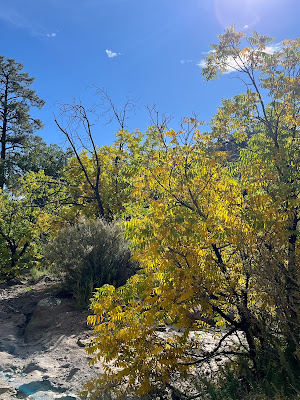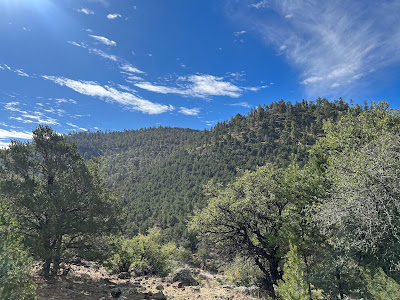 |
| Las Animas Creek |
 |
| North Seco Creek |
 |
| Las Animas Creek |
 |
| Looking down to Las Animas |
 |
| Sycamore |
 |
| Padilla Homestead |
 |
| Artifacts, grinding mortars at the Padilla Homestead |
 |
| North Seco Creek |
We visited the Ladder Ranch for the second time a couple of weeks ago (10/14/23). Andrea had given me another full day tour for my birthday. We first looked at areas where they are doing endangered species work with tortoises and prairie dogs that are the southern edge of the ranch. After switching to a side by side ATV at the ranch headquarters we then headed up Las Animas Creek. Initially, after crossing the creek, we went high above it on a very primitive road because of a very narrow box canyon. Eventually, though we descended back to the stream bottom. I have nothing good to say about the section of road that brought us down. It is not for the faint-hearted.

Down in the valley were sycamores, cottonwoods, alders, and ash trees. Some were still bright green, others beginning to turn. The creek, a few inches of tea colored water, trickled in the middle providing for this miraculous riparian display. We visited the old Padilla Homestead with its crumbling adobe walls. Just a few yards from the stream, it was a desert scene with mesquite and thorny shrubs poised to engulf the place.




Further on we encountered areas where the bosque had burned in the Black Fire and got a look at a few petroglyphs as well.
For the second half of our trip, I wanted to get over to Emrick Canyon which is tributary on the south side of South Palomas.That meant getting up and out of Las Animas on a "road" that was equally unnerving as the road that had brought us down. We then moved over on the high plateau to descend to first South Seco Creek and then on to its confluence with North Seco. The vast, grassy table lands of the Ladder Ranch are just spectacular to behold, but without time and right light of day, no photograph that I could take would do any sort of justice to the feelings of awe I get when encountering them. I refrained. In addition the prairie dog, and the tortoises from early in the day before going up Las Animas, along our trek we saw wolves (in their pens), bison, turkeys, deer, red tailed hawks, lizards, a burrowing owl, scaled quail and many smaller birds that our guide Ken Stinnett pointed out to us.
In North Seco, there were springs, but no flowing stream. Narrowleaf cottonwoods were turning bright yellow against the sinuous gray cliffs of conglomerate. A beautiful scene.

NOTE: the Ladder Ranch is private property and not open to the public. You must arrange (and pay) for a tour through Ted Turner Reserves.
Labels: archaeology, big trees, fall colors, ghost towns, history, petroglyphs, scenic driving




















































